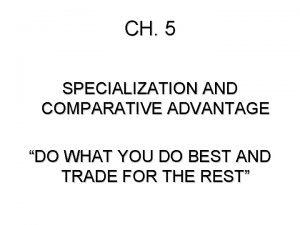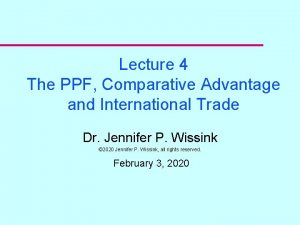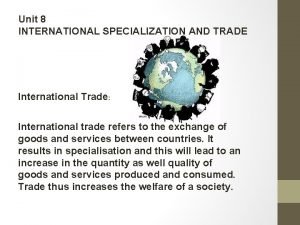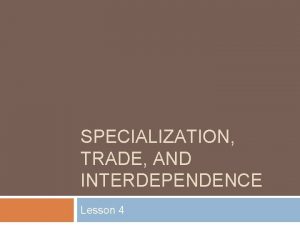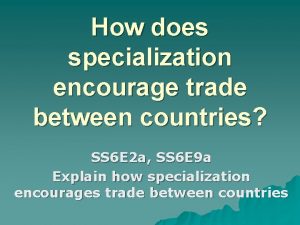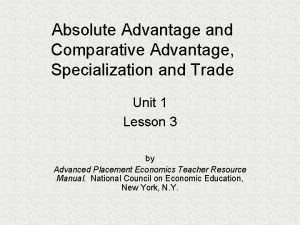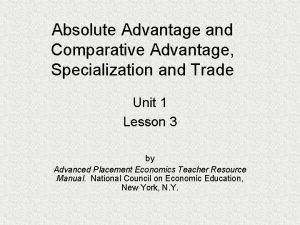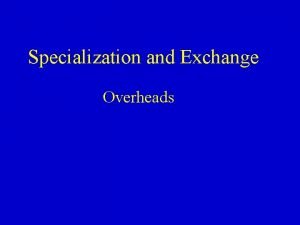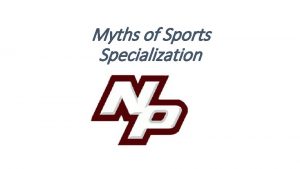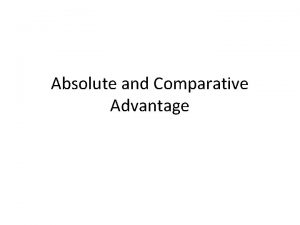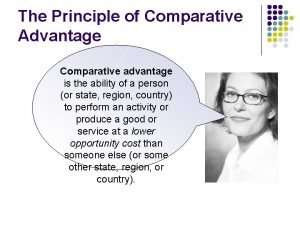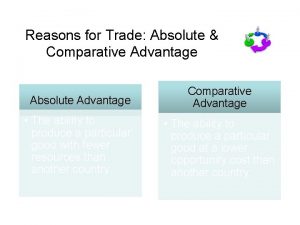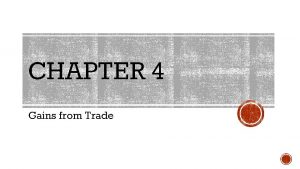Comparative Advantage and Specialization Sports and Trade Williams



















- Slides: 19

Comparative Advantage and Specialization Sports and Trade Williams Economics

Key Terms Specialization Comparative Advantage Absolute Advantage Opportunity Cost

Specialization Concentration on producing things that a country can produce most efficiently Why do countries specialize? n Specialization means focusing on strengths n Success means maximizing profit (increased exports) Why do sports teams specialize? n Specialization means focusing on strengths n Success in sports means maximizing profit n Teams want specialty players who will bring up attendance

Absolute Advantage vs. Comparative Advantage When a country can produce more of the same “resources” than another country, they have an absolute advantage. Comparative advantage encourages countries to produce those goods for which they have the lower opportunity cost than another country In sports, comparative advantage explains why some athletes play one sport over another or one position over another

Neighborly Comparative Advantage explains why specialization arises even when other people enjoy absolute advantage in producing all goods Comparative advantage=do what you do best and trade for rest (or find substitute supplier) Chore Total Time Spent in Minutes ADAM DAVID Minutes Spent on Each Chore W/O Trade w/Trade Mow lawn 40 120 160 Weed garden 60 100 160 200 Time working without trade 100 2 320 Time working with trade 80 200 -- 280 Net gain from trade 20 20 -- 40 20 80 --

Comparative Advantage U. S. and Japan Labor to make computers Labor to grow a ton of wheat U. S. 100 Japan 120 5 8 COPY this chart into your notebook to answer the following question in class. §What country has the absolute advantage in computer production? §What country has the absolute advantage in wheat production?

Assume US allocates labor: 100 units to computers 200 units to wheat Assume Japan allocates labor: 120 to computers 180 to wheat ØHow much wheat and computers does the U. S. produce? ØHow much wheat and computers does Japan produce? ØWhat are “world” production totals?

What if U. S. allocates all of its production to wheat and Japan produces as many computers as possible? How much does the “world” produce? v. Japan converts wheat to computers at the rate of ____ tons wheat to 1 computer v. U. S. sacrifices production of more wheat than Japan in the production of 1 computer v. U. S. has comparative advantage in production of wheat v. Japan has comparative advantage in production of computers

Opportunity Cost Opportunity cost: trade-off; what you give up for decisions If U. S. makes decision to produce both computers and wheat, it gives up the opportunity to make more wheat Decision to play a sport or play a certain position in sports has opportunity costs. Ex: If you play running back in football, you give up the opportunity to throw the ball.

The Story of Babe Ruth §Greatest power hitters in history of Major League baseball §Left-hand pitcher §Begin professional career with Boston Red Sox in 1914 §By 1915, was starting pitcher § 1916 -leads American League in earned run average and shutouts; finished third in strike-outs and wins §Leads Red Sox to win World Series championships in 1915, 1916, 1918

Babe, cont’d String of consecutive scoreless innings pitched was 29 No designated hitters at time On days he didn’t pitch, Babe was first baseman or outfielder As part-time hitter, hit 11 home runs in 1918 (tied in American League) Most runs hit by team members: 1 !! 1918 -1919: Out of 46 homeruns hit by Red Sox, he hits 40 (86%); with only 11% of team’s at bats, accounts for 24% of runs batted in

Babe Goes to New York Contract sold to New York Yankees in 1920 Yankees want to sell seats and impressed with Babe’s home run legacy Yankees break league attendance record by 1920 and win American League Pennant 7 times between 1920 and 1932; Yankees also win 4 World Series

The Statistics Pitching Records of the Boston Red Sox 1915 -1918 Wins Losses Wins/(Wins + Losses) Foster 41 22 0. 651 Shore 48 34 0. 585 Leonard 57 42 0. 576 Mays 67 40 0. 626 Ruth 78 40 0. 661 Total 291 178 0. 620

Hitting Records of the Boston Red Sox 1918 -1919 Team Ruth/ Team At Bats Hits Batting Home Ave Runs 6, 647 749 1, 789 234 0. 269 0. 313 46 40 Runs Batted In 754 180 0. 113 0. 131 -- 0. 87 0. 24

Hitting Records of the New York Yankees 1920 -1924 Team Ruth/ Team At Bats Hits Batting Average Home Runs Batted In 21, 891 2, 455 6, 655 908 0. 304 0. 370 516 235 3, 337 659 0. 112 0. 136 -- 0. 455 0. 197

Pitching Records of the New York Yankees 1920 -1924 Wins/(Wins + Wins Losses) Mays Shawkey Hoyt Bush 66 90 73 62 44 59 47 38 0. 600 0. 604 0. 608 0. 620 Jones Pennock Quinn Collins Total 43 40 26 25 425 27 15 17 13 260 0. 614 0. 727 0. 605 0. 658 0. 620

What was Babe’s Comparative Advantage? Ruth’s comparative advantage was contingent on how substitutes for him contributed to the team’s win ratio Yankees had a strong pitching staff; didn’t need Ruth had a comparative advantage as a hitter for the Yankees because they had a stronger pitching staff.

New York could show off Ruth’s talents unlike the Red Sox Attendance and receipts increased As a hitter, Ruth helped the Yankees achieve the possible win ratio for their team Comparative advantage explains why Babe Ruth, the best pitcher in the American League in the late 1920 s, specialized in hitting home runs after Boston traded him to the New York Yankees.

Summary Answer the following questions? 1. What would have been the Yankees' opportunity cost of using Babe Ruth as a pitcher? Note: A pitcher does not usually pitch in every game and hence, will not be in the batter lineup every game. 2. If the Yankees had a poor pitching staff, in which position(s) would Babe Ruth have a comparative advantage?
 Specialization and comparative advantage
Specialization and comparative advantage Comparative advantage vs absolute advantage
Comparative advantage vs absolute advantage International specialization and trade
International specialization and trade Activity 26.5 specialization and trade answers
Activity 26.5 specialization and trade answers How is specialization connected to interdependence
How is specialization connected to interdependence Verna health and social
Verna health and social Does specialization encourage trade with other countries?
Does specialization encourage trade with other countries? Specialization in trade
Specialization in trade Andy williams robert williams
Andy williams robert williams Robbie williams janet williams
Robbie williams janet williams Indoor outdoor sports
Indoor outdoor sports Actual mechanical advantage vs ideal mechanical advantage
Actual mechanical advantage vs ideal mechanical advantage Trade diversion and trade creation
Trade diversion and trade creation Umich
Umich Which is the most enduring free trade area in the world?
Which is the most enduring free trade area in the world? Trade diversion and trade creation
Trade diversion and trade creation Liner shipping and tramp shipping
Liner shipping and tramp shipping When discussing comparative and absolute advantage
When discussing comparative and absolute advantage The trade in the trade-to-gdp ratio
The trade in the trade-to-gdp ratio Fair trade not free trade
Fair trade not free trade
